#edith windsor
Text
I picked the name Edith for my serger at random but then I got to thinking about Edith "Edie" Windsor, a lesbian civil rights activist who sued the United States government in 2013 in order to strike down a law called the Defense of Marriage Act (we referred to it as DOMA at the time) that prohibited federal recognition if same sex marriages. And she won!
This made it so that same sex marriages in states that had legalized same sex marriage already (at the time a handful, Washington and Colorado having done so the year before) were recognized federally. And it paved the way for the Obergefell v Hodges ruling that legalized same sex marriage nationwide.
We would not have same sex marriage without her. I cried when she died. So now my serger is named after her.
18 notes
·
View notes
Text



Edith Windsor and Thea Spyer (1969)
#edith windsor#thea spyer#queer history#sapphic#wlw#lesbian#queer#vintage lesbians#vintage photography#1960s
86 notes
·
View notes
Text
23 ottobre … ricordiamo …
23 ottobre … ricordiamo …
#semprevivineiricordi #nomidaricordare #personaggiimportanti #perfettamentechic
2020: Maria Grazia Bon, attrice italiana. (n. 1943)
2019: Roberta Fiorentini, attrice italiana, nota soprattutto per il ruolo di Itala nella serie televisiva Boris. (n. 1948)
2018: James Karen, attore statunitense. (n. 1923)
2012: Corrado Lojacono, cantante, attore e compositore italiano. Debuttò alla radio nel 1945. (n. 1924)
1999: Luciano Soprani, stilista italiano. (n. 1946)
1994: Robert…
youtube
View On WordPress
#23 ottobre#Barry O&039;Moore#Bertram Yost#Claire Windsor#Clara Viola Cronk#Corrado Lojacono#Dorothy Dunbar#Edith Augusta Dunbar#Herbert Yost#James Karen#Jean Joseph Charles Toulout#Jean Toulout#Luciano Soprani#Maria Grazia Bon#Morti 23 ottobre#Robert Lansing#Roberta Fiorentini#Susan Peters#Suzanne Carnahan#Youtube
0 notes
Text
Tues. Sept. 13, 2022: Fun With Friends
Tues. Sept. 13, 2022: Fun With Friends
image courtesy of Fancycrave1 via pixabay.com
Tuesday, September 13, 2022
Waning Moon
Pluto, Saturn, Neptune, Chiron, Jupiter, Uranus, Mercury
Cloudy and humid
I completely forgot to post an intention for the week yesterday; I knew I’d scheduled something to post, and it was for the GDR site, not this one. Oops.
Friday and Saturday were about getting the house ready for guests, and cooking…

View On WordPress
#"Forever In your Debt#cats#Edith Wharton#GDR#Kellie Rae Adams#Legerdemain#MassMOCA#post#rain#Story telling#The Mount#Windsor Lake
0 notes
Text
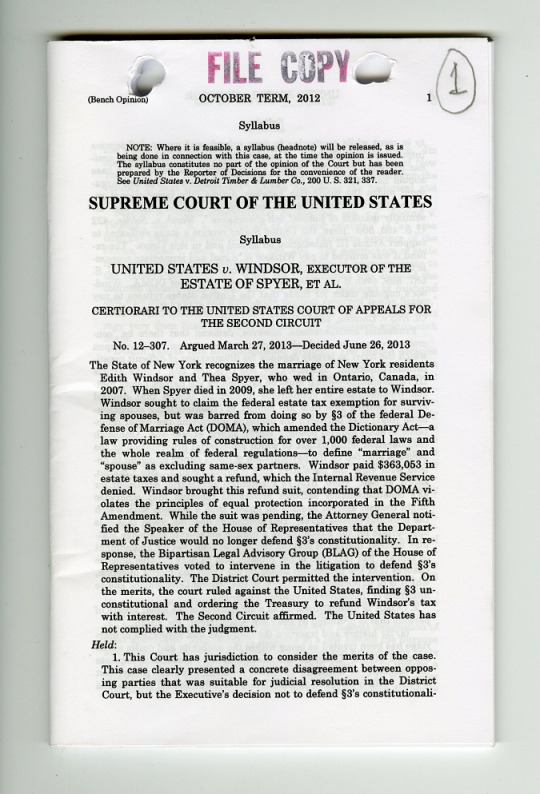
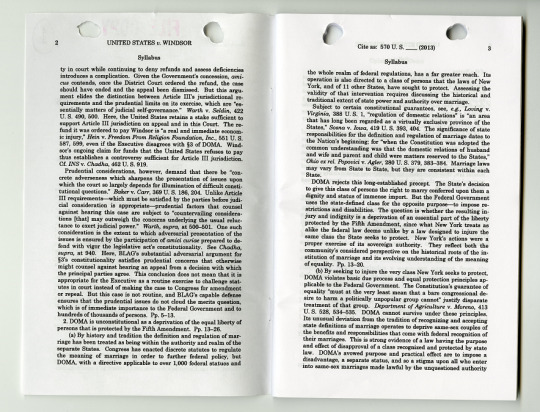
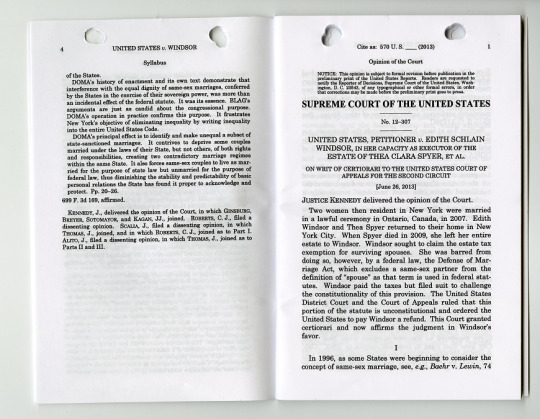
The Supreme Court ruled that the Defense of Marriage Act was unconstitutional on June 26, 2013.
In U.S. v Windsor, SCOTUS held that the federal government could not discriminate against same-sex couples.
Record Group 267: Records of the Supreme Court of the United States
Series: Appellate Jurisdiction Case Files
Transcription:
[Stamped: " FILE COPY "]
(Bench Opinion) OCTOBER TERM, 2012 1 [Handwritten and circled " 1" in upper right-hand corner]
Syllabus
NOTE: Where it is feasible, a syllabus (headnote) will be released, as is
being done in connection with this case, at the time the opinion is issued.
The syllabus constitutes no part of the opinion of the Court but has been
prepared by the Reporter of Decisions for the convenience of the reader.
See United States v. Detroit Timber & Lumber Co., 200 U.S. 321, 337.
SUPREME COURT OF THE UNITED STATES
Syllabus
UNITED STATES v. WINDSOR, EXECUTOR OF THE
ESTATE OF SPYER, ET AL.
CERTIORARI TO THE UNITED STATES COURT OF APPEALS FOR
THE SECOND CIRCUIT
No. 12-307. Argued March 27, 2013---Decided June 26, 2013
The State of New York recognizes the marriage of New York residents
Edith Windsor and Thea Spyer, who wed in Ontario, Canada, in
2007. When Spyer died in 2009, she left her entire estate to Windsor.
Windsor sought to claim the federal estate tax exemption for surviv-
ing spouses, but was barred from doing so by §3 of the federal Defense
of Marriage Act (DOMA), which amended the Dictionary Act---a
law providing rules of construction for over 1,000 federal laws and
the whole realm of federal regulations-to define "marriage" and
"spouse" as excluding same-sex partners. Windsor paid $363,053 in
estate taxes and sought a refund, which the Internal Revenue Service
denied. Windsor brought this refund suit, contending that DOMA vi-
olates the principles of equal protection incorporated in the Fifth
Amendment. While the suit was pending, the Attorney General notified
the Speaker of the House of Representatives that the Department
of Justice would no longer defend §3's constitutionality. In re-
sponse, the Bipartisan Legal Advisory Group (BLAG) of the House of
Representatives voted to intervene in the litigation to defend §3's
constitutionality. The District Court permitted the intervention. On
the merits, the court ruled against the United States, finding §3 un-
constitutional and ordering the Treasury to refund Windsor's tax
with interest. The Second Circuit affirmed. The United States has
not complied with the judgment.
Held:
1. This Court has jurisdiction to consider the merits of the case.
This case clearly presented a concrete disagreement between oppos-
ing parties that was suitable for judicial resolution in the District
Court, but the Executive's decision not to defend §3's constitutionali-
[page 2]
2 UNITED STATES v. WINDSOR
Syllabus
ty in court while continuing to deny refunds and assess deficiencies
introduces a complication. Given the Government's concession, ami-
cus contends, once the District Court ordered the refund, the case
should have ended and the appeal been dismissed. But this argu-
ment elides the distinction between Article Ill's jurisdictional re-
quirements and the prudential limits on its exercise, which are "es-
sentially matters of judicial self-governance." Warth v. Seldin, 422
U. S. 490, 500. Here, the United States retains a stake sufficient to
support Article III jurisdiction on appeal and in this Court. The re-
fund it was ordered to pay Windsor is "a real and immediate econom-
ic injury," Hein v. Freedom From Religion Foundation, Inc., 551 U. S.
587, 599, even if the Executive disagrees with §3 of DOMA. Wind-
sor's ongoing claim for funds that the United States refuses to pay
thus establishes a controversy sufficient for Article III jurisdiction.
Cf. INS v. Chadha, 462 U. S. 919.
Prudential considerations, however, demand that there be "con-
crete adverseness which sharpens the presentation of issues upon
which the court so largely depends for illumination of difficult consti-
tutional questions." Baker v. Carr, 369 U. S. 186, 204. Unlike Article
III requirements---which must be satisfied by the parties before judi-
cial consideration is appropriate---prudential factors that counsel
against hearing this case are subject to "countervailing considera-
tions [that] may outweigh the concerns underlying the usual reluc-
tance to exert judicial power." Warth, supra, at 500-501. One such
consideration is the extent to which adversarial presentation of the
issues is ensured by the participation of amici curiae prepared to de-
fend with vigor the legislative act's constitutionality. See Chadha,
supra, at 940. Here, BLAG's substantial adversarial argument for
§3's constitutionality satisfies prudential concerns that otherwise
might counsel against hearing an appeal from a decision with which
the principal parties agree. This conclusion does not mean that it is
appropriate for the Executive as a routine exercise to challenge stat-
utes in court instead of making the case to Congress for amendment
or repeal. But this case is not routine, and BLAG's capable defense
ensures that the prudential issues do not cloud the merits question,
which is of immediate importance to the Federal Government and to
hundreds of thousands of persons. Pp. 5-13.
2. DOMA is unconstitutional as a deprivation of the equal liberty of
persons that is protected by the Fifth Amendment. Pp. 13--26.
(a) By history and tradition the definition and regulation of mar-
riage has been treated as being within the authority and realm of the
separate States. Congress has enacted discrete statutes to regulate
the meaning of marriage in order to further federal policy, but
DOMA, with a directive applicable to over 1,000 federal statues and
[NEW PAGE]
Cite as: 570 U.S._ (2013) 3
Syllabus
the whole realm of federal regulations, has a far greater reach. Its
operation is also directed to a class of persons that the laws of New
York, and of 11 other States, have sought to protect. Assessing the
validity of that intervention requires discussing the historical and
traditional extent of state power and authority over marriage.
Subject to certain constitutional guarantees, see, e.g., Loving v.
Virginia, 388 U.S. 1, "regulation of domestic relations" is "an area
that has long been regarded as a virtually exclusive province of the
States," Sosna v. Iowa, 419 U. S. 393, 404. The significance of state
responsibilities for the definition and regulation of marriage dates to
the Nation's beginning; for "when the Constitution was adopted the
common understanding was that the domestic relations of husband
and wife and parent and child were matters reserved to the States,"
Ohio ex rel. Popovici v. Agler, 280 U. S. 379, 383-384. Marriage laws
may vary from State to State, but they are consistent within each
State.
DOMA rejects this long-established precept. The State's decision
to give this class of persons the right to marry conferred upon them a
dignity and status of immense import. But the Federal Government
uses the state-defined class for the opposite purpose---to impose re-
strictions and disabilities. The question is whether the resulting injury
and indignity is a deprivation of an essential part of the liberty
protected by the Fifth Amendment, since what New York treats as
alike the federal law deems unlike by a law designed to injure the
same class the State seeks to protect. New York's actions were a
proper exercise of its sovereign authority. They reflect both the
community's considered perspective on the historical roots of the in-
stitution of marriage and its evolving understanding of the meaning
of equality. Pp. 13--20.
(b) By seeking to injure the very class New York seeks to protect,
DOMA violates basic due process and equal protection principles ap-
plicable to the Federal Government. The Constitution's guarantee of
equality "must at the very least mean that a bare congressional de-
sire to harm a politically unpopular group cannot" justify disparate
treatment of that group. Department of Agriculture v. Moreno, 413
U. S. 528, 534-535. DOMA cannot survive under these principles.
Its unusual deviation from the tradition of recognizing and accepting
state definitions of marriage operates to deprive same-sex couples of
the benefits and responsibilities that come with federal recognition of
their marriages. This is strong evidence of a law having the purpose
and effect of disapproval of a class recognized and protected by state
law. DOMA's avowed purpose and practical effect are to impose a
disadvantage, a separate status, and so a stigma upon all who enter
into same-sex marriages made lawful by the unquestioned authority
[page 3]
4 UNITED STATES v. WINDSOR
Syllabus
of the States.
DOMA's history of enactment and its own text demonstrate that
interference with the equal dignity of same-sex marriages, conferred
by the States in the exercise of their sovereign power, was more than
an incidental effect of the federal statute. It was its essence. BLAG's
arguments are just as candid about the congressional purpose.
DOMA's operation in practice confirms this purpose. It frustrates
New York's objective of eliminating inequality by writing inequality
into the entire United States Code.
DOMA's principal effect is to identify and make unequal a subset of
state-sanctioned marriages. It contrives to deprive some couples
married under the laws of their State, but not others, of both rights
and responsibilities, creating two contradictory marriage regimes
within the same State. It also forces same-sex couples to live as mar-
ried for the purpose of state law but unmarried for the purpose of
federal law, thus diminishing the stability and predictability of basic
personal relations the State has found it proper to acknowledge and
protect. Pp. 20-26.
699 F. 3d 169, affirmed.
KENNEDY, J., delivered the opinion of the Court, in which GINSBURG,
BREYER, SOTOMAYOR, and KAGAN, JJ., joined. ROBERTS, C. J., filed a
dissenting opinion. SCALIA, J., filed a dissenting opinion, in which
THOMAS, J., joined, and in which ROBERTS, C. J., joined as to Part I.
ALITO, J., filed a dissenting opinion, in which THOMAS, J., joined as to
Parts II and III.
[NEW PAGE]
Cite as: 570 U. S. _ (2013) 1
Opinion of the Court
NOTICE: This opinion is subject to formal revision before publication in the
preliminary print of the United States Reports. Readers are requested to
notify the Reporter of Decisions, Supreme Court of the United States, Washington,
D. C. 20543, of any typographical or other formal errors, in order
that corrections may be made before the preliminary print goes to press.
SUPREME COURT OF THE UNITED STATES
No. 12-307
UNITED STATES, PETITIONER v. EDITH SCHLAIN
WINDSOR, IN HER CAPACITY AS EXECUTOR OF THE
ESTATE OF THEA CLARA SPYER, ET AL.
ON WRIT OF CERTIORARI TO THE UNITED STATES COURT OF
APPEALS FOR THE SECOND CIRCUIT
[June 26, 2013]
JUSTICE KENNEDY delivered the opinion of the Court.
Two women then resident in New York were married
in a lawful ceremony in Ontario, Canada, in 2007. Edith
Windsor and Thea Spyer returned to their home in New
York City. When Spyer died in 2009, she left her entire
estate to Windsor. Windsor sought to claim the estate tax
exemption for surviving spouses. She was barred from
doing so, however, by a federal law, the Defense of Mar-
riage Act, which excludes a same-sex partner from the
definition of "spouse" as that term is used in federal stat-
utes. Windsor paid the taxes but filed suit to challenge
the constitutionality of this provision. The United States
District Court and the Court of Appeals ruled that this
portion of the statute is unconstitutional and ordered the
United States to pay Windsor a refund. This Court granted
certiorari and now affirms the judgment in Windsor's
favor.
I
In 1996, as some States were beginning to consider the
concept of same-sex marriage, see, e.g., Baehr v. Lewin, 74
#archivesgov#June 26#2013#2010s#Pride#LGBTQ+#LGBTQ+ history#U.S. v Windsor#Defense of Marriage Act#same-sex marriage#Supreme Court#SCOTUS
143 notes
·
View notes
Text

June is LGBTQ+ #PrideMonth and the National Archives has many online resources on issues of sexual identity and rights, including articles, educational materials, videos, and blog posts, all based on the records in our holdings.
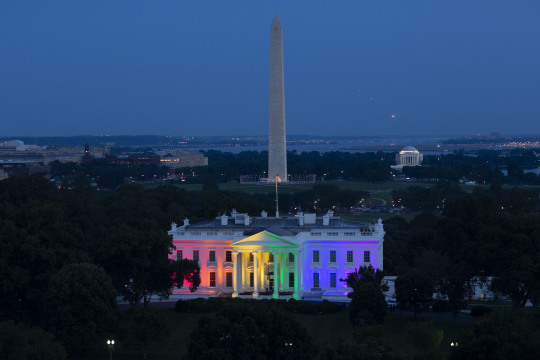
Resources:
Discovering LGBTQ History: Pride Flag Given to President Obama,
Pieces of History: Pride in Protesting: 50th Anniversary of the Stonewall Uprising
Discovering LGBTQ History: Marriage in Minnesota, 1970
The Wedding Heard ’Round the World: America’s First Gay Marriage
Amending America: LGBTQ Human and Civil Rights
Establishment of Stonewall National Monument in the Federal Register
U.S. v. Edith Windsor (gay marriage/Defense of Marriage Act case)
Pieces of History: American Pride for Astronaut Sally Ride
Speech of San Francisco Supervisor Harvey Milk at Gay Freedom Day, June 25, 1978
“Don’t Ask, Don’t Tell” Repeal Act of 2010
DocsTeach: Primary Sources related to LGBTQ+
DocsTeach: The Long Struggle for LGBTQ+ Civil Rights
DocsTeach: “We Are Badly in Need of a Breath of Fresh Air”: A Letter to President Kennedy About LGBTQ+ Rights
87 notes
·
View notes
Text
Ages of English Princesses at First Marriage
I have only included women whose birth dates and dates of marriage are known within at least 1-2 years, therefore, this is not a comprehensive list. The average age at first marriage among these women was 16.
This list is composed of princesses of England when it was a sovereign state, prior to the Acts of Union in 1707.
Eadgyth (Edith) of England, daughter of Edward the Elder: age 20 when she married Otto the Great, Holy Roman Emperor in 930 CE
Godgifu (Goda) of England, daughter of Æthelred the Unready: age 20 when she married Drogo of Mantes in 1024 CE
Empress Matilda, daughter of Henry I: age 12 when she married Henry, Holy Roman Emperor, in 1114 CE
Marie I, Countess of Boulogne, daughter of Stephen of Blois: age 24 when she was abducted from her abbey by Matthew of Alsace and forced to marry him, in 1136 CE
Matilda of England, daughter of Henry II: age 12 when she married Henry the Lion in 1168 CE
Eleanor of England, daughter of Henry II: age 9 when she married Alfonso VIII of Castile in 1170 CE
Joan of England, daughter of Henry II: age 12 when she married William II of Sicily in 1177 CE
Joan of England, daughter of John Lackland: age 11 when she married Alexander II of Scotland in 1221 CE
Isabella of England, daughter of John Lackland: age 21 when she married Frederick II, Holy Roman Emperor, in 1235 CE
Eleanor of England, daughter of John Lackland: age 9 when she married William Marshal, Earl of Pembroke in 1224 CE
Margaret of England, daughter of Henry III: age 11 when she married Alexander III of Scotland in 1251 CE
Beatrice of England, daughter of Henry III: age 17 when she married John II, Duke of Brittany in 1260 CE
Eleanor of England, daughter of Edward I: age 24 when she married Henry III, Count of Bar in 1293 CE
Joan of Acre, daughter of Edward I: age 18 when she married Gilbert de Clare, Earl of Gloucester in 1290 CE
Margaret of England, daughter of Edward I: age 15 when she married John II, Duke of Brabant in 1290 CE
Elizabeth of Rhuddlan, daughter of Edward I: age 15 when she married John I, Count of Holland in 1297 CE
Eleanor of Woodstock, daughter of Edward II: age 14 when she married Reginald II, Duke of Guelders in 1332 CE
Joan of the Tower, daughter of Edward II: age 7 when she married David II of Scotland in 1328 CE
Isabella of England, daughter of Edward III: age 33 when she married Enguerrand VII, Lord of Coucy in 1365 CE
Mary of Waltham, daughter of Edward III: age 16 when she married John IV, Duke of Brittany in 1361 CE
Margaret of Windsor, daughter of Edward III: age 13 when she married John Hastings, Earl of Pembroke in 1361 CE
Blanche of England, daughter of Henry IV: age 10 when she married Louis III, Elector Palatine in 1402 CE
Philippa of England, daughter of Henry IV: age 12 when she married Eric of Pomerania in 1406 CE
Elizabeth of York, daughter of Edward IV: age 20 when she married Henry VII in 1486 CE
Cecily of York, daughter of Edward IV: age 16 when she married Ralph Scrope in 1485 CE
Anne of York, daughter of Edward IV: age 19 when she married Thomas Howard in 1494 CE
Catherine of York, daughter of Edward IV: age 16 when she married William Courtenay, Earl of Devon in 1495 CE
Margaret Tudor, daughter of Henry VII: age 14 when she married James IV of Scotland in 1503 CE
Mary Tudor, daughter of Henry VII: age 18 when she married Louis XII of France in 1514 CE
Mary I, daughter of Henry VIII: age 38 when she married Philip II of Spain in 1554 CE
Elizabeth Stuart, daughter of James VI & I: age 17 when she married Frederick V, Elector Palatine in 1613 CE
Mary Stuart, daughter of Charles I: age 10 when she married William II, Prince of Orange in 1641 CE
Henrietta Stuart, daughter of Charles I: age 17 when she married Philippe II, Duke of Orleans in 1661 CE
Mary II of England, daughter of James II: age 15 when she married William III of Orange in 1677 CE
Anne, Queen of Great Britain, daughter of James II: age 18 when she married George of Denmark in 1683 CE
27 notes
·
View notes
Text
The 1920s - part 3
The Designers
Lucien Lelong
The man who saved Paris!
The story of how he saved Parisian couture in the face of hostile takeover by the Nazis in WW2 has overshadowed his creative legacy.
Lucien Lelong is one of the most important French designers of the years 1920-1930, contemporary of Chanel, Schiaparelli, Patou, Worth and Lanvin. As he was born into a family of designers he was destined to make it in this industry. Unfortunately his career was put on hold due to the First World War. He was sent to the trenches, where he served as an intelligence officer.

After the war Lucien Lelong resumed his career at the same time as Coco Chanel's fashion house was taking off. While she was a creative innovator, it was Lelong who showed the strongest business acumen by offering discounts to society women who agreed to be photographed in his dresses. Marlene Dietrich and the Duchess of Windsor were his models.
The business boomed. By 1926 he employed 1,200 staff and had moved to 16 rue Matignon, off the Champs-Elysées.
Lucien Lelong's style, similar to Chanel's, was influenced by sport and the idea movement as well as the body in motion. His word for clothes' capacity to move with the body was kinétique. He wanted them as he said, 'to be constructed in such a way that their true shape would emerge in movement, not at rest'.
In Paris during the 1920s, Madeleine Vionnet was linked with draping, Jean Patou with chic, Lucien Lelong with fluidity. Dressmaking, in his hands, became engineering. He transformed dresses with narrow pleats that moved with the garment but fell back into place when the wearer was still.
Lucien Lelong Party Frock
The dress and over blouse of grey georgette, the dress is finely pleated, sewn with layers of rhinestones, the waist defined with a band of rhinestones and central crescent shape, the over blouse sleeveless, sewn with regularly spaced rhinestones and a rhinestone hem.
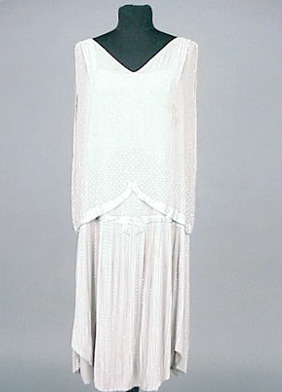
He was one of the first designers to consider the fashion on different levels, dealing with the production of clothing but also accessories and fragrances.
From 1925 to 1950 he created approximately 40 perfumes.


His muse was his second wife, Natalie Paley, she was a Russian princess of the Romanov family 'an icy beauty' with a natural elegance that inspired many photographers such as Horst, Beaton, Man Ray.

In 1929, after the Wall Street Crash, Paris losta lot of its profitable American market and the ‘Garçonne' style of the 1920s, the boyish, short-skirted and tubular dresses died with it. As well as the Wall Street Crash, Patou's 1929 collection killed the Garçonne by lowering the hemlines to mid-calf which did not fit the style of the 'Garçonne'.
Natalie Paley was the face of the new look and the 1930s, her husband's decade. She kept her bone-thin figure by eating little and she would visit Lucien Lelong's salon to try on clothes and acted as his consultant.

The evening dresses that Lelong produced throughout the 1930s still look modern today, this is because they were influenced by neoclassical drapery. However, French fashion was entering a time of crisis. Protective economic policies in America saw a 90% import tax charged on French couture. The effect of this was a flood of cheap copies from American factories. American women started taking fashion inspiration not from Paris but from Hollywood and the designs of studio costumers such as Edith Head and Adrian.
In 1918 at the end of WWI Lucien Lelong opened his own fashion Salon. He developed the talents of up and coming Designers, such as Pierre Balmain, Christian Dior and Hubert de Givency.
For almost 30 years the House of Lucien Lelong epitomized Parisian elegance, it had a clientele drawn from international society and the arts. He was well known for his beautiful fabrics and his great understanding of dresses and evening wear. For health reasons he closed his studio in 1948, but continued with the production of perfumes until his death, in 1958.
Jean Patou
Jean Patou was born in Normandy, France, at a young age he was inspired to enter the world of fashion. His father, Charles Patou, owned a successful business as a tanner, although being inspired by his father’s brilliant use of colourful leathers in book binding, Jean Patou only worked with him for a short time, before striking out on his own.
After a few failed ventures as a tailor, Patou succeeded in opening a dress shop in Paris during 1912. Two years later, just as he was gaining popularity, thanks to a generous American department store buyer who purchased his entire collection, World War I halted the fashion industry in Paris. He fought for five years in the war.

Jean Patou's collections of 1920 and 1921 represented his worldly influences from his time in the war. He drew inspiration from Russian influences and his use of scarves as girdles was published in Vogue on October 15, 1921 as one of his signature designs.
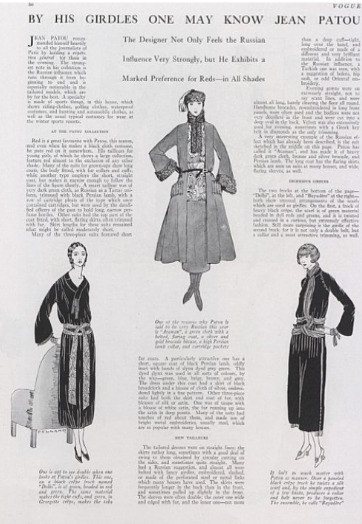
Also signature to Patou was his women's sportswear, which was similar to Chanel. He used jersey, in which was originally used for menswear, to design silhouettes that were considered much easier to move in for the more modern and active woman that emerged in the 20’s.

He designed for tennis player Suzanne Lenglen, he set a new scandalous trend consisting of calf-length skirts and a sleeveless cardigan. This new silhouette created a lot of press for Jean Patou including a spread in Vogue featuring Suzanne Lenglen ("Fashion: Suzanne Lenglenshows how to Dress for Tennis." Vogue Dec 01 1926).
Because of the bold fashion designs for the modern woman of the 20s, Patou’s legacy can be appreciated by today’s modern women and designers. He opened the door to a sportswear industry that was looked over but now just as much about looking incredible and showing off a designer label as was about being comfortable and active.

The free mind-set of the 20’s influenced Patou from multiple directions. He saw a need for simple and functional women’s clothing but also viewed trends like cubism and art deco as unique and extravagant inspirations.
The freedom women began to demand and experience during the “Roaring Twenties,” including exercising, showing their legs and sunbathing, created a gap in the fashion industry that Patou knew how to fill. Historians have said that Patou was known for being a playboy who never married and the reason for his great understanding of the modern woman was because he was with so many of them. He objectified them in a way that allowed him to view their needs as well as create designs that appealed to men.

The Twenties were truly the beginning of the marketing and advertising industry that we know today. Jean Patou was ahead of his time, he advertised his brand by branding himself, he did this by monogramming his garments with JP, in order to protect his designs from knock offs. Creating this signature logo of his initials began a trend that has become essential to marketing campaigns and growing a company brand even today, brands such as Ralph Lauren, nike and adidas. His clothing was about status and even though many women who wore his active wear did not exercise in it, they got it to show off to their friends that they wore JP designs.
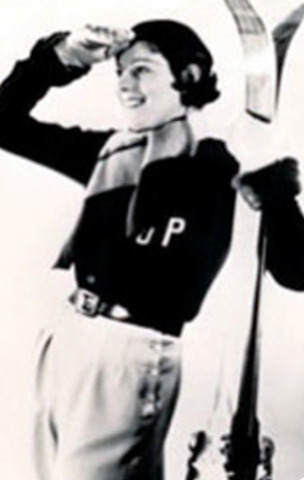
Patou’s perfume creations were another status symbol that helped continue his legacy through to present day. His most successful was 'Joy'. It was stated to be the most expensive scent in the world. Each bottle contained 10,600 jasmine flowers and 336 roses.



Jean Patou spent a huge proportion of his career trying to break out of Chanel’s overwhelming shadow. It was stated that in 1929 he premiered a bias cut, white satin, evening gown as a statement to Chanel’s little black dress and said, “I shall fight with all my influence to banish the much too simple little black frock from the ranks of fashionable” throwing shade on to coco Chanel. He set the trend for the early thirties by lowering the hemline back to the ankles. Jean Patou is forever an icon in the fashion industry because of his bold choices and excellent ability to create a sought-after brand.

In the 1920s, Patou created the first ever designer tie, he cut patterns from silk fabrics historically reserved for women’s wear. His innovation empowered the accessory turning it into more than just a tie which before then was more of an afterthought but now into a focal point for a man's attire, influencing future tie makers from Christian Dior to Paul Smith. The range of different designs that Patou has influenced is vast and forever inspiring.

A couturier of modern times, Jean Patou embraced Art Deco, here are some of his illustrations.



Coco Chanel
The young Gabrielle Bonheur Chanel was sent to the orphanage of the Catholic monastery of Aubazine at 6 years old, where she learned the trade of a seamstress.

During the 1920s, Coco Chanel became the first designer to create a loose women's jersey, traditionally used for men's underwear, creating a relaxed style for women and ignoring the stiff corseted look of the time. They quickly became very popular with clients, a post-war generation of women for whom the corseted restricted clothing seemed old-fashioned and impractical moving on too a new era of fashion.By the 1920s, the house of Chanel was established at the location of 31, rue Cambon in Paris (which remains its headquarters to this day). It become a fashion force to be reckoned with. Chanel became a style icon herself due to her striking bob haircut and tan placing her at the cutting edge of modern style.
The use of a monochrome colour palette was present in her oversized 'costume' pearls and cuffs, everything is still sublimely, continuously referenced. As she herself once said:
"Fashion fades, only style remains the same."
The Chanel jacket is undeniably one of fashion's chicest and most enduring pieces in the house and fashion. First created by the label's founder, Coco Chanel, the item was intended to free women from the constraints of the cinched-in silhouettes of the Fifties.

youtube
This short film stars Keira Knightley as the label Chanel's visionary founding designer and focuses on the opening of her debut store in 1913, found in the French seaside town of Deauville.
4 notes
·
View notes
Text
The 2022 PWI #Womens150 Full List 1-150
1.Syuri
2.Bianca Belair
3.Thunder Rosa
4.Becky Lynch
5.Jade Cargill
6.Jordynne Grace
7.Saya Kamitani
8.Charlotte Flair
9.Starlight Kid
10.Taya Valkyrie
11. Tasha Steelz
12. Miyu Yamashita
13. Dr Britt Baker D.M.D
14. Masha Slamovich
15. Mickie James
16. AZM
17. Liv Morgan
18. Ronda Rousey
19. Deonna Purrazzao
20. Utami Hayashishita
21. Mandy Rose
22. Meiko Satomura
23. Kamille
24. Alex Windsor
25. Toni Storm
26. Sasha Banks
27. Mayu Iwatani
28. Mercedes Martinez
29. Shoko Nakajima
30. Tam Nakano
31. Gisele Shaw
32. Princess Sugehit
33. Hyan
34. Arisa Nakajima
35. Emersyn Jayne
36. Roxanne Perez
37. Maki Itoh
38. Dark Silueta
39. Momo Watanabe
40. Willow Nightingale
41. Suzu Suzuki
42. Rhea Ripley
43. Yuka Sakazaki
44. Tsukasa Fujimoto
45. Jetta
46. Lu Fisto
47. Naomi
48. Gigi Dolin
49. Jacy Jayne
50. Viva Van
51. Allie Katch
52. Billie Starks
53. Trish Adora
54. Charli Evans
55. Natsupoi
56. Savannah Evans
57. Giulia
58. Holidead
59. Risa Sera
60. Ruby Soho
61. Asuka
62. Shazza Mckenzie
63. Tootie Lynn
64. Jamie Hayter
65. Hikaru Shida
66. Rosemary
67. Rina Yamashita
68. Jessica Troy
69. Thekla
70. Edith Surreal
71. Hikari Noa
72. Sandra Moone
73. Laura Di Matteo
74. Jordan Blade
75. Chelsea Green
76. Athena
77. Serena Deeb
78. Mirai
79. K.C. Spinelli
80. KiLynn King
81. Natalya
82. Miu Watanabe
83. Cora Jade
84. Veny
85. Raquel Rodriguez
86. Allysin Kay
87. Saori Anou
88. Dana Brooke
89. Miranda Alize
90. Marti Belle
91. Koguma
92. Nicole Matthews
93. Mei Suruga
94. Shayna Baszler
95. Laynie Luck
96. Leila Grey
97. Doudrop
98. Blair Davenport
99. Christi Jaynes
100. Kiera Hogan
101. Hazuki
102. Baby Allison
103. Anna Jay
104. Lady Shani
105. Nanae Takahashi
106. Raychell Rose
107. Lady Frost
108. Mizuki
109. Nikki Cross
110. Skye Blue
111. Alexxis Falcon
112. Red Velvet
113. Kanji
114. Ivelisse
115. Janai Kai
116. Taryn From Accounting
117. Alexa Bliss
118. Marina Shafir
119. Dakota Kai
120. Yuki kamifuku
121. Erica Leigh
122. Savannah Summers
123. Mina Shirakawa
124. B3CCA
125. Kris Statlander
126. Iyo Sky
127. Tay Melo
128. Debbie Keitel
129. Makoto
130. Max The Impalaer
131. Iva Kolasky
132. Hanan
133. Mia Yim
134. Takumi Iroha
135. Natalia Markova
136. Joey Threat
137. Shotzi
138. Charlie Morgan
139. Davienne
140. Freya The Slaya
141. La Hiedra
142. Liiza Hall
143. Kylie Rae
144. Joseline Navarro
145. Dani Mo
146. Alexia Nicole
147. Loue O'Farrell
148. Kayla Sparks
149. Riley Shepard
150. Hyper Misao

9 notes
·
View notes
Text
O, Christmas Tree
Early December, 1800, Windsor
Gwendoline looked at the tree sitting atop Edith’s table in her lounge, dressed with candles and an angel.
“Why,” she asked, looking to her dear sister, Edith, who was currently warming her hands by the fire, her gloves tucked under her armpit, her hat thrown haphazardly onto a nearby settee, “Have you got that?”
“Hmm?” Edith asked, pulling her hands back from the fire and almost dropping a glove from them on the settee as well, “I really should have some thicker gloves made. What was that, Gwen?” she turned around and Gwendoline gestured to the tree, “An, the tree! It’s a German thing, her majesty had one set up for Christmas in her apartments and encouraged me to have one in my rooms. Lovely, isn’t it?”
“Yes,” Gwen said slowly, carefully, her gloves still on, her hat in hand, “do the candles not burn the tree?”
“Oh, I rarely have them lit, only when I have company, they never have a chance to, really.”
Gwen hummed, blinked, eyed the thing, “Why a tree, of all things?”
“Well,” Edith stopped, puzzled opening and closing her mouth, “I don’t know, you will have to ask Hanover when she gets here.”
Gwendoline didn’t know Hanover was coming for Christmas, or else she would have stayed north in her own home for the season, or stayed with Moire. They were terribly sappy despite Edith’s complaints about her, their, she supposes, other half. They stood in silence, Edith still trying to warm up after their ride here on horseback, not the wisest decision, admittedly, but Gwen had grown bored of sitting in carriages all the way from Cardiff to London.
“Look, if you do not like it, just say—“
“I like it.” Gwendoline said, which was only half true, “I was simply commenting on it, as it is rather unexpected.”
Edith eyed Gwen, “I’ll take the candles off, if you are so worried.”
Gwen went to object before chewing her lips, thinking, looking at the tree, it’s many spines, a smaller version of the trees they used to find up north in Norway on the rare occasion when they would visit, the ones she would use for fire woods.
“Please.”
Also posted on ao3 if anyone’s curious
Though Victoria and Albert are largely credited with popularising the Christmas tree, Queen Charlotte is generally regarded as being the first to bring it over here, having one set up in Windsor in 1800
#not a reblog for once#writing#hetalia#hws england#hws wales#nyo england#nyo wales#this was fun to write
4 notes
·
View notes
Text
How Edith Windsor Revolutionized LGBT Estate Planning
Love stories come in all shapes and sizes, defying societal norms and carving their own paths through history. One such love story, penned in courage and ink, belongs to Edith Windsor and Thea Spyer, two remarkable women who transformed the landscape of LGBT estate planning in the United States. The Backstory Their journey began in New York City in the 1960s, where they met and fell in love, building a life together for 42 years. They shared laughter, tears, triumphs, and everyday moments, weaving a tapestry of love that defied the discriminatory tapestry of the times. In 2007, Thea tragically [Read more...]
The post How Edith Windsor Revolutionized LGBT Estate Planning appeared first on Augulis Law Firm. http://dlvr.it/T20Q1C
0 notes
Text
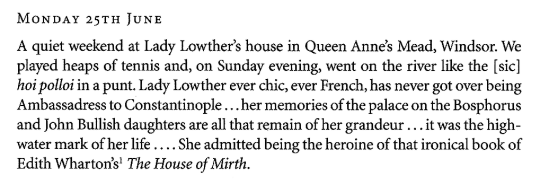
Henry ‘Chips’ Channon: The Diaries (Vol. 1), 1918-38, entry for 25th June 1923
—
Monday 25th June
A quiet weekend at Lady Lowther’s house in Queen Anne’s Mead, Windsor. We played heaps of tennis and, on Sunday evening, went on the river like the [sic] hoi polloi in a punt. Lady Lowther ever chic, ever French, has never got over being Ambassadress to Constantinople ... her memories of the palace on the Bosphorus and John Bullish daughters are all that remain of her grandeur ... it was the high-water mark of her life .... She admitted being the heroine of that ironical book of Edith Wharton’s¹ The House of Mirth.
—
1. Edith Newbold Jones (1862-1937), married in 1885 to Edward Robbins Wharton, was an American novelist of the belle époque, known for her depictions of American society. Her 1905 novel The House of Mirth was the story of a woman who rose through society from humble origins, and attacks the corruption and decadence of the elite.
1 note
·
View note
Text
June 20 ZODIAC
They are double individuals, anxious and apprehensive naturally, however they need to grow intellectually, accumulate information and take a stab at nuance. In spite of the fact that their personality is very conflicting, their psyche is especially dynamic, continually distracted with considerations, projects, plans, and so forth. They frequently change the object of their advantage. Diligent, alterable, they look for bliss on the planet, however they are in many cases in the mists. Extremely incautious, they can likewise be unequivocal and imperious. They are enriched with different capacities and can use their influence merciful, without offending their subordinates. Imperfections: They are uncertain individuals and readily understand the activities and contemplations of others. His disposition is anxious, fretful, frequently digressing into negativity. Along these lines, they may not work by any means, bringing about deserted and undiscovered activities. It should be added, notwithstanding, that they have a specific strength, maybe an old pride. They are exceptionally dedicated and battle for a reasonable position.
June 20 ZODIAC
In the event that your birthday is June 20, your zodiac sign is Gemini
June 20 - character and character
character: cautious, dependable, friendly, garrulous, muddled, dubious calling: artist, clerk, software engineer tones: silver, purple, child blue stone: emerald creature: squirrel plant: potato plant fortunate numbers: 13,18,38,50,51,57 very fortunate number: 35
Occasions and observances - June 20
Displaced person Day in Africa. Held in Africa, by understanding of the OAU
Argentina: Banner Day (public occasion).
World Exile Day. Embraced by the Unified Countries General Get together, goal 55/76 (broken connect accessible on Web Chronicle; see history and most recent adaptation). the 2000.
June 20 Superstar birthday celebrations. Who was conceived that very day as you?
1902: Juan Evaristo, Argentine soccer player (d. 1979). 1902: Roberto Fugazot, Uruguayan entertainer and vocalist (d. 1971). 1905: Lillian Hellman, American writer (d. 1984). 1909: Errol Flynn, American entertainer (d. 1959). 1910: Francisco Martდnez Cordero, Mexican b-ball player (f. 1993) 1913: Juan de Borbდ³n y Battenberg, Spanish blue-blood (f. 1993). 1913: Lilian Jackson Braun, American author (d. 2011). 1915: Terence Youthful, English movie producer (d. 1994). 1917: Helena Rasiowa, Clean mathematician (d. 1994) 1918: Luis Pena Illescas, Spanish entertainer (d. 1977). 1920: Eduardo Mondlane, Mozambican legislator (d. 1969). 1920: Amos Tutuola, Nigerian author (d. 1997). 1921: Jean Dieuzaide, French picture taker (f. 2003). 1922: Ernesto Bianco, Argentine entertainer (d. 1977). 1924: Chet Atkins, American guitarist and maker (d. 2001). 1924: Audie Murphy, military man and American entertainer (d. 1971). 1924: Rainer Barzel, German legislator (d. 2006). 1925: Doris Hart, American tennis player (d. 2015). 1926: Giovanni Viola, Italian footballer. (F. 2008) 1928: Jean-Marie Le Pen, French lawmaker. 1928: Eric Dolphy, American jazz performer (d. 1964). 1928: Martin Landau, American entertainer. (f. 2017) 1928: Hu Hesheng, Chinese mathematician. 1929: Josდ© Vicente Grecco, Argentine footballer (f. 2008). 1929: Edith Windsor, American LGBT extremist. (f. 2017). 1930: Magdalena Abakanowicz, Clean craftsman. 1930: Marდa Aurelia Bisutti, Argentine entertainer (d. 2010). 1931: Olympia Dukakis, American entertainer. 1931: Mary L. Great, American inorganic scientist. 1933: Apathetic Lester, American blues artist. 1933: Danny Aiello, American entertainer. 1934: Sergio Balanzino, Italian legislator and Secretary General of NATO. 1935: Armando Picchi, Italian footballer (d. 1971). 1940: Josep Maria Benet, Spanish writer. 1940: Umanosuke Ueda, Japanese expert grappler (d. 2011). 1940: John Mahoney, American entertainer. 1940: Eugen Drewermann, German scholar. 1941: Stephen Frears, English producer. 1941: Josep-Ignasi Saranyana, thinker, scholar, Spanish teacher. 1942: Brian Wilson, American artist of the Ocean side Young men band. 1945: Shekhar Mehta, Kenyan meeting driver (d. 2006). 1945: Anne Murray, Canadian artist. 1945: Jean-Claude Izzo, French author (d. 2000). 1946: Xanana Gusmao, Timorese president somewhere in the range of 2002 and 2007. 1948: Ludwig Scotty, Nauruan president somewhere in the range of 2003 and 2007. 1949: Lionel Richie, American artist and entertainer of the band The Commodores. 1950: Nuri al-Maliki, Iraqi government official and head of the state beginning around 2006. 1950: Tetდ© Coustarot, model and host of Argentine radio and TV. 1951: Braid MacNeille, American voice entertainer. 1952: John Goodman, American entertainer. 1952: Mabel Rivera, Spanish entertainer. 1952: Vikram Seth, Indian writer. 1953: Ulrich Mდ¼he, German entertainer (d. 2007). 1954: Michael Anthony, American artist of the band Van Halen. 1954: Amparo Munoz, Spanish entertainer (d. 2011). 1954: Ilan Ramon, Israeli space explorer (d. 2003). 1959: Venancio Ramos, Uruguayan soccer player. 1960: John Taylor, English bassist, of the band Duran. 1961: Javivi, Spanish entertainer. 1964: Remedios Cervantes, Spanish model. 1964: Silke Mდ¶ller, German competitor. 1967: Edu Ardanuy, Brazilian guitarist, of the band Dr. Sin. 1967: Nicole Kidman, Australian entertainer. 1968: Robert Rodriguez, American producer. 1968: Barry Sparkles, American bassist, of the band Dokken. 1969: Josდ© Luis Calva Zepeda, Mexican writer and killer (d. 2007). 1969: Peter Paige, American entertainer. 1969: Paulo Bento previous Portuguese soccer player and mentor. 1970: Moulay Rachid, Moroccan ruler. 1971: Josh Lucas, American entertainer. 1971: Rodney Rogers, American ball player. 1971: Jeordie White, American guitarist, of the band Marilyn Manson. 1973: Chino Moreno, American artist, of the band Deftones. 1973: Jenდlson დ‚ngelo de Souza, Brazilian soccer player. 1974: Moacir Bastos, Brazilian soccer player. 1975: Daniel Zდtka, Czech footballer. 1975: Joan Balcells, Spanish tennis player. 1975: Nut case, American rapper. 1976: Juliano Belletti, Brazilian soccer player. 1976: Jerome Fontamillas, Filipino artist, of the band Switchfoot. 1976: Carlos Lee, Panamanian baseball player. 1977: Gordan Giriე?ek, Croatian ball player. 1977: Claudia Troyo, Mexican TV entertainer 1977: Roberto Carlos Cortდ©s, Colombian soccer player. 1978: Straight to the point Lampard, English footballer. 1980: Fabian Wegmann, German cyclist. 1980: Milovan Mirosevic, Chilean-Croatian footballer. 1980: Franco Semioli, Italian footballer. 1981: Joseba Del Olmo, Spanish footballer. 1981: Ardian Gashi, Norwegian footballer. 1982: George Forsyth, Peruvian footballer. 1982: Aleksდ©i Berezutski, Russian footballer. 1982: Vasili Berezutski, Russian footballer. 1982: Model, English artist. 1983: Miguel დ?ngel Benდtez Gდ³mez, Spanish artist, of the band Los Delinqდ¼entes (f. 2004). 1983: Josh Childress, American ball player. 1983: Carolina Ramდrez, Colombian entertainer and artist 1984: Jarrod Smith, New Zealand soccer player. 1985: Darko Miliე?iე‡, Serbian ball player. 1985: Saki Aibu, Japanese entertainer. 1986: Andrდ©s de la Cruz, Spanish entertainer. 1986: Euphoria Huerta, Mexican vocalist, from the couple Jesse and Bliss. 1988: Shefali Chowdhury, English entertainer. 1989: Christopher Mintz-Plasse, American entertainer. 1989: Javier Pastore, Argentine footballer.
1902: Juan Evaristo, Argentine soccer player (d. 1979). 1902: Roberto Fugazot, Uruguayan entertainer and vocalist (d. 1971). 1905: Lillian Hellman, American writer (d. 1984). 1909: Errol Flynn, American entertainer (d. 1959). 1910: Francisco Martდnez Cordero, Mexican b-ball player (f. 1993) 1913: Juan de Borbდ³n y Battenberg, Spanish blue-blood (f. 1993). 1913: Lilian Jackson Braun, American author (d. 2011). 1915: Terence Youthful, English movie producer (d. 1994). 1917: Helena Rasiowa, Clean mathematician (d. 1994) 1918: Luis Pena Illescas, Spanish entertainer (d. 1977). 1920: Eduardo Mondlane, Mozambican legislator (d. 1969). 1920: Amos Tutuola, Nigerian author (d. 1997). 1921: Jean Dieuzaide, French picture taker (f. 2003). 1922: Ernesto Bianco, Argentine entertainer (d. 1977). 1924: Chet Atkins, American guitarist and maker (d. 2001). 1924: Audie Murphy, military man and American entertainer (d. 1971). 1924: Rainer Barzel, German legislator (d. 2006). 1925: Doris Hart, American tennis player (d. 2015). 1926: Giovanni Viola, Italian footballer. (F. 2008) 1928: Jean-Marie Le Pen, French lawmaker. 1928: Eric Dolphy, American jazz performer (d. 1964). 1928: Martin Landau, American entertainer. (f. 2017) 1928: Hu Hesheng, Chinese mathematician. 1929: Josდ© Vicente Grecco, Argentine footballer (f. 2008). 1929: Edith Windsor, American LGBT extremist. (f. 2017). 1930: Magdalena Abakanowicz, Clean craftsman. 1930: Marდa Aurelia Bisutti, Argentine entertainer (d. 2010). 1931: Olympia Dukakis, American entertainer. 1931: Mary L. Great, American inorganic scientist. 1933: Apathetic Lester, American blues artist. 1933: Danny Aiello, American entertainer. 1934: Sergio Balanzino, Italian legislator and Secretary General of NATO. 1935: Armando Picchi, Italian footballer (d. 1971). 1940: Josep Maria Benet, Spanish dramatist. 1940: Umanosuke Ueda, Japanese expert grappler (d. 2011). 1940: John Mahoney, American entertainer. 1940: Eugen Drewermann, German scholar. 1941: Stephen Frears, English producer. 1941: Josep-Ignasi Saranyana, thinker, scholar, Spanish teacher. 1942: Brian Wilson, American artist of the Ocean side Young men band. 1945: Shekhar Mehta, Kenyan meeting driver (d. 2006). 1945: Anne Murray, Canadian artist. 1945: Jean-Claude Izzo, French author (d. 2000). 1946: Xanana Gusmao, Timorese president somewhere in the range of 2002 and 2007. 1948: Ludwig Scotty, Nauruan president somewhere in the range of 2003 and 2007. 1949: Lionel Richie, American artist and entertainer of the band The Commodores. 1950: Nuri al-Maliki, Iraqi government official and head of the state beginning around 2006. 1950: Tetდ© Coustarot, model and host of Argentine radio and TV. 1951: Braid MacNeille, American voice entertainer. 1952: John Goodman, American entertainer. 1952: Mabel Rivera, Spanish entertainer. 1952: Vikram Seth, Indian writer. 1953: Ulrich Mდ¼he, German entertainer (d. 2007). 1954: Michael Anthony, American artist of the band Van Halen.
0 notes
Text
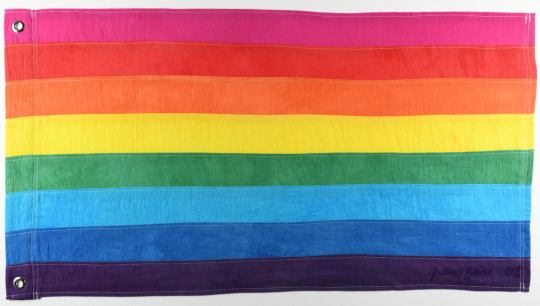
Pride flag given to President Obama at the White House LGBT Pride Reception, 2016. Barack Obama Presidential Library. NARA ID 219756312.
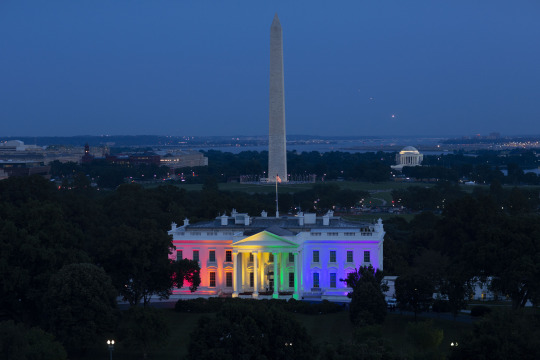
The Obama White House lit in celebration of the Supreme Court ruling on same-sex marriage, 6/26/2015. Obama Library, NARA ID 176549838.
HAPPY PRIDE MONTH!
By Miriam Kleiman, Public Affairs

People Celebrate the Supreme Court Ruling on Same-Sex Marriage outside the White House 6/26/2015. Image by Amanda Lucidon, Obama Library, NARA ID 138925688.
We celebrate Pride Month with some highlights from our holdings. Today we focus on rainbows and happiness, but future Pride Month posts will reflect the country's documented history of systemic discrimination and violence towards the LGBTQ community.

LGBT DC Pride 6/6/2014 tweet from Shin Inouye, records of the Obama Presidential Library. NARA ID 231832627.

President Obama with Gilbert Baker, Gay Pride Flag artist, White House, 6/9/2016. NARA ID 176549434.
More onilne:
National Archives News Special Topics page: LGBTQ+ Pride Month
Discovering LGBTQ History: Pride Flag Given to President Obama,
Pieces of History: Pride in Protesting: 50th Anniversary of the Stonewall Uprising
Discovering LGBTQ History: Marriage in Minnesota, 1970
The Wedding Heard ’Round the World: America’s First Gay Marriage
Amending America: LGBTQ Human and Civil Rights
Establishment of Stonewall National Monument in the Federal Register
U.S. v. Edith Windsor (gay marriage/Defense of Marriage Act case)
Pieces of History: American Pride for Astronaut Sally Ride
Speech of San Francisco Supervisor Harvey Milk at Gay Freedom Day, June 25, 1978
“Don’t Ask, Don’t Tell” Repeal Act of 2010
DocsTeach: Primary Sources related to LGBTQ+
DocsTeach: The Long Struggle for LGBTQ+ Civil Rights
DocsTeach: "We Are Badly in Need of a Breath of Fresh Air": A Letter to President Kennedy About LGBTQ+ Rights
#pride 2022#pride month#lgbtq#lgbtq positivity#civil rights#lgbtq community#gay#loveislove#obama#obama library#lgbt
641 notes
·
View notes
Text
I love the stories of people who never wanted to be involved in politics being the ones who change major policies.
Edith Windsor and her wife never wanted to be involved in politics, they didnt actively fight for the federal government to make gay marriage legal, it only happened because Ediths wife died and Edith was being kicked out of the home she shared with her wife for decades.
Politics and social change is fought by everyday people just trying to live their lives.
0 notes
Text
THE ACQUITTAL
1919

The Acquittal is a play in three acts by Rita Weiman. The original production was produced by George M. Cohan and Sam Harris, staged by Sam Forrest.
The cast featured William Harrigan, son of the late entertainer Ned Harrigan. Young Harrigan was recently returned from military service overseas.
Kenneth Winthrop is tried for the murder of his foster-father, Andrew Prentice. His foster-brother, Robert Armstrong is his accuser. Both love Madeline, who has chosen Winthrop. Armstrong alleges that Edith Craig, secretly engaged to the dead man, and Winthrop were in love, but it is not believed. Circumstantial evidence is introduced offering the time as given by a certain clock. Madeline discovers that what they took for a clock in a butcher's store window was a circular meat scale, the hand of which stays at twelve, the top of the scale, when not in use. This discovery clears her husband. A postal inspector produces a letter written on the night of the murder by Prentice, which had been stolen in a mail holdup and recovered. This letter solves the whole mystery and puts the guilt on the shoulders of Prentice, who then confesses and commits suicide. Madeline finally finds happiness with Armstrong, who has always loved her.

The Acquittal premiered in Atlantic City NJ at Nixon’s Apollo Theatre on the Boardwalk on June 30, 1919. It then traveled to Asbury Park and Long Branch.

Instead of moving directly across the river to Broadway, the play decamped to Chicago beginning September 21st. This is likely to await the availability of Cohan and Harris’ flagship theatre on the Rialto. It stayed in the Windy City until December 27, 1919. It made a quick trip to Baltimore before Broadway.

The Acquittal opened on Broadway at the Cohan and Harris Theatre (226 West 42nd Street) on January 5, 1920.
About the Venue: The Cohan and Harris was in 1914 as the Candler, and leased to George M. Cohan and Sam H. Harris until 1920, when they ended their partnership. Harris kept the theatre, renaming it for himself. In 1926, he sold it to the Shuberts, who lost it in a 1933 bankruptcy. It was a movie house from 1933 to 1978 and demolished in 1996. It became part of Madame Tussaud's Wax Museum.
“Do any of you remember that jangly old song titled ‘Harrigan, That's Me'? If you do, you can testify that the gentleman of the piece was more than ordinarily boastful of his ability; that there was very little H A double R I G A N could not do. All of which is a prelude to our statement that ‘The Acquittal,’ Rita Weiman's new drama at the Cohan and Harris Theatre, is made by an unassuming young man of that name. William Harrigan's playing of the square, slangy, likable reporter of The Chronicle, Joe Conway, is one of the best bits of acting we have seen in some time.” ~ McELLIOTT, NY DAILY NEWS
The play closed on May 1, 1920, after 138 performances. After a short break, the play went out on tour again. Harrigan, and Chrystal Herne remained with the cast.
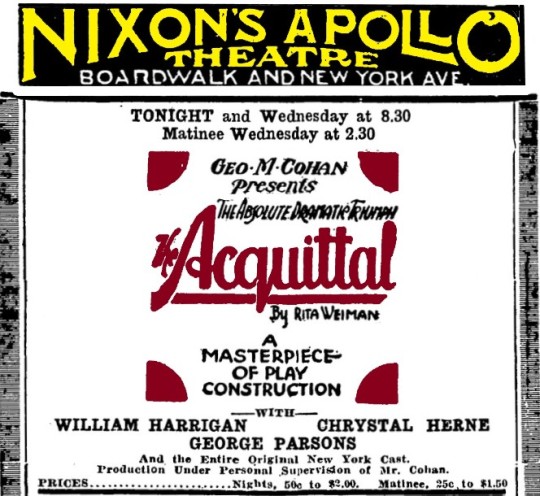
During its post-Broadway tour, the play returned to Atlantic City and Nixon’s Apollo on October 4, 1920.

In 1923, a film version was released by Universal. The film was directed by Clarence Brown starring Norman Kerry, Claire Windsor, Richard Travers, and Barbara Bedford.

The film opened in Atlantic City at the Bijou Theatre on the Boardwalk on November 23, 1923.

In 1953, the play was adapted for television as an installment of “Broadway Television Theatre” on WOR TV, syndicated from New York City. It starred John Baragrey and Judith Evelyn.
#The Acquittal#George M. Cohan#Sam Harris#William Harrigan#Rita Weiman#Drama#Broadway#Broadway Play#Atlantic City#Nixon's Apollo Theatre#Boardwalk
1 note
·
View note